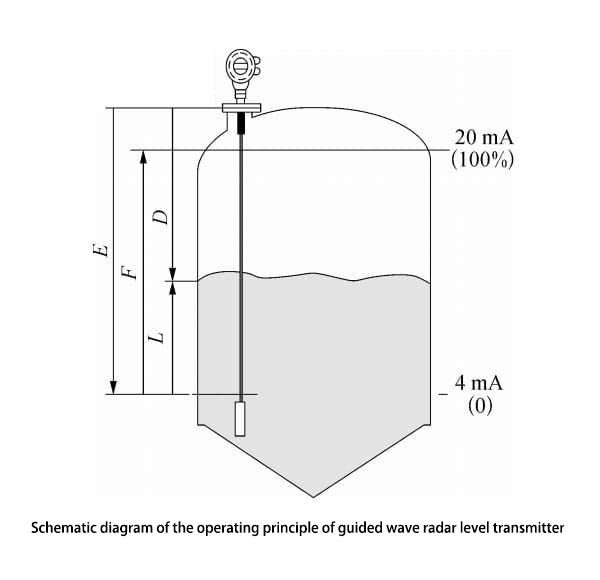In a variety of industrial scenarios, accurately measuring the level of liquids is key to ensuring the stability and safety of the production process. Radar level transmitters are a popular choice for liquid level measurement due to their high accuracy and reliability.
Introduction of radar level transmitter
Radar is a technology that utilizes electromagnetic waves for measurement and detection. Radar level transmitters measure the distance between the surface of a liquid and the sensor by transmitting and receiving microwave signals to determine the level of the liquid.
Working principle of the radar transmitter
- Signal emission: the transmitter of the radar level transmitter emits microwave signals to the surface of the liquid.
- Signal reflection: a part of the microwave signal is reflected back by the liquid surface, the formation of the return signal.
- Signal reception and calculation: the receiver receives the echo signal, and calculates the time required to transmit the signal to return to the echo signal, i.e., “time of flight”.
- Level measurement: the flight time is multiplied by the speed of signal propagation (usually the speed of light) to calculate the distance between the surface of the liquid and the sensor.
- Level conversion: The calculated distance is converted to a level measurement and transmitted to a display or control system.
Let’s take an example:
First, the transmitter of the radar level transmitter emits a high-frequency microwave signal. The emitted microwave signal passes through the water in the settling tank and reaches the surface of the water, part of the signal is reflected by the surface of the water and returns, and the receiver receives the signal reflected back from the surface of the water. By measuring the time between transmitting the signal and receiving the reflected signal (time of flight), the radar level transmitter calculates the distance between the water surface and the sensor. The calculated distance value is converted into a level measurement and transmitted to a display or monitoring system.

Key points in the operational process:
- Continuous monitoring: The radar level transmitter continuously sends and receives signals to ensure real-time monitoring of the liquid level in the settling tank.
- Level change analysis: By monitoring changes in liquid level, it is possible to understand the progress of the settling process and wastewater treatment, so that appropriate measures can be taken to adjust the treatment process.
- Reflection and interference problems: It is necessary to pay attention to the reflection of the signal on the surface of the liquid, while avoiding the interference of the signal by factors such as air bubbles, foam or turbidity of the sewage.
Advantages and Cautions:
- High accuracy measurement: Radar technology can provide high accuracy level measurement and maintain accuracy even in harsh environments.
- Environmental adaptability: Able to cope with different effluent characteristics, but need to pay attention to possible reflection and interference problems during signal propagation to ensure the accuracy of measurement.
There are different types of radar level transmitters, each of which may have a slightly different principle of operation. Below are a few common types of radar level transmitters and their main working principles:
- Pulse radar: Transmits a microwave signal in short pulses and measures the time of flight of the signal to determine the liquid level. It is suitable for a wide range of media and industrial environments because of its short operating time.
- Continuous wave radar: continuously emits microwave signals to identify liquid levels by frequency or phase changes. Suitable for high-precision measurements and interference-prone environments.
- Non-contact radar: the use of FM continuous wave technology, can be in the liquid surface of different dielectric constant to provide more accurate measurement, suitable for a variety of media and harsh environments.
- Leaky wave radar(guided wave radar level transmitter): Measures liquid level by introducing a microwave signal into a waveguide tube and allowing it to interact with the medium. Suitable for applications with small level variations.


Each type of radar level transmitter differs slightly in principle and application, but all are based on radar technology, which utilizes the reflection of a microwave signal against the surface of a liquid to measure the level. Selection of the right type for a particular application depends on factors such as media properties, measurement requirements and environmental conditions.
Typical applications for radar level transmitters
Radar level transmitters are commonly used in a variety of industrial scenarios where accurate measurement of liquid levels is required, including but not limited to the following areas:
- Chemical plants and process installations: Used to monitor the level of chemicals in storage tanks, reactors, tanks or pipelines.
- Oil and gas industry: Used for level monitoring in tanks, storage tanks, pipelines, etc., to help control the storage, transportation and handling of oil and liquid gases.
- Water and wastewater treatment: In wastewater treatment plants, it is used to monitor the level of sewage tanks, sedimentation tanks, water tanks and so on.
- Food and beverage industry: for monitoring the level of tanks or troughs in food production, such as the storage of raw materials in brewing, dairy or beverage production.
- Energy production and power plants: for monitoring the level of fuel storage tanks, cooling pools, etc..
- Pharmaceutical industry: for pharmaceutical equipment in the liquid storage tanks or reactor level monitoring.
Summary
Radar level transmitters utilize microwave signals to accurately measure liquid levels and determine the distance between the liquid and the sensor by calculating the signal’s time of flight. Although reliable, attention should be paid to the effects of signal reflection and external interference on accuracy. Overall, it provides a reliable technical solution for industrial monitoring and control with high accuracy and stability.
Apure offers level transmitters in addition to water quality analyzers, flow measurement, pressure measurement, temperature measurement and ozone generators.
